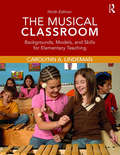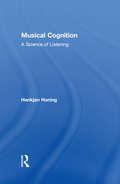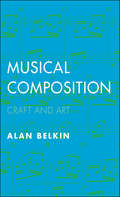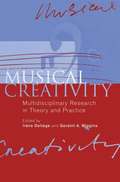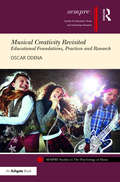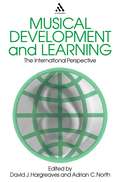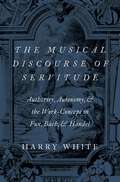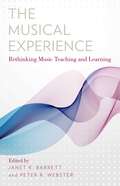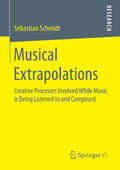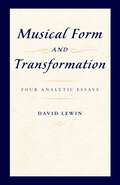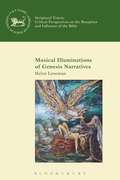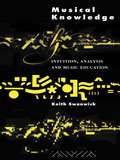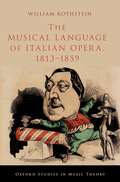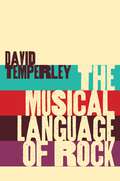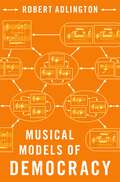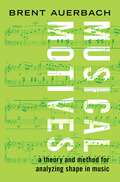- Table View
- List View
The Musical Classroom: Backgrounds, Models, and Skills for Elementary Teaching
by Carolynn A. LindemanThe Musical Classroom: Backgrounds, Models, and Skills for Elementary Teaching, Ninth Edition, is designed for students majoring in elementary or music education. Through eight editions, this book has been a market leader in its field. Its goal has been to help teachers—some who may only have a limited background in music—prepare to make music a part of the daily lives of their students. The model lessons remain the centerpiece of the book's long-lasting success. Supported by a collection of children's songs from around the world, instructional information for learning to play basic instruments, and the theoretical, pedagogical, and practical backgrounds needed for reaching all learners, pre-service and in-service teachers can make their classrooms musical classrooms. NEW to the ninth edition: The 2014 National Core Music Standards Multiple curricular connections to other subjects Expanded soprano recorder instruction unit Addition of the QChord® with Autoharp®/Chromaharp® instruction unit Updated and expanded prekindergarten section A significant infusion of technology throughout the text Mallet-instrument ensemble accompaniments A companion website linking to music sources with numerous resources for both students and instructors
Musical Composition: Craft and Art
by Alan BelkinAn invaluable introduction to the art and craft of musical composition from a distinguished teacher and composerThis essential introduction to the art and craft of musical composition is designed to familiarize beginning composers with principles and techniques applicable to a broad range of musical styles, from concert pieces to film scores and video game music. The first of its kind to utilize a style-neutral approach, in addition to presenting the commonly known classical forms, this book offers invaluable general guidance on developing and connecting musical ideas, building to a climax, and other fundamental formal principles. It is designed for both classroom use and independent study.
Musical Creativity: Multidisciplinary Research In Theory And Practice (PDF)
by Irène Deliège Geraint A. WigginsThis collection initiates a resolutely interdisciplinary research dynamic specifically concerning musical creativity. Creativity is one of the most challenging issues currently facing scientific psychology and its study has been relatively rare in the cognitive sciences, especially in artificial intelligence. This book will address the need for a coherent and thorough exploration. Musical Creativity: Multidisciplinary Research in Theory and Practicecomprises seven sections, each viewing musical creativity from a different scientific vantage point, from the philosophy of computer modelling, through music education, interpretation, neuroscience, and music therapy, to experimental psychology. Each section contains discussions by eminent international specialists of the issues raised, and the book concludes with a postlude discussing how we can understand creativity in the work of eminent composer, Jonathan Harvey. This unique volume presents an up-to-date snapshot of the scientific study of musical creativity, in conjunction with ESCOM (the European Society for the Cognitive Sciences of Music). Describing many of the different aspects of musical creativity and their study, it will form a useful springboard for further such study in future years, and will be of interest to academics and practitioners in music, psychology, cognitive science, artificial intelligence, neuroscience and other fields concerning the study of human cognition in this most human of behaviours.
Musical Creativity Revisited: Educational Foundations, Practices and Research (SEMPRE Studies in The Psychology of Music)
by Oscar OdenaHow is creativity understood and facilitated across music education settings? What is the power of creativity in enhancing individual and group learning? How is musical creativity used as a tool for cross-community integration? How can we research the interactions of those engaged in musical activities aimed at creative development? These are just some of the questions addressed in this fascinating new monograph. Musical Creativity Revisited is an authoritative volume of insights from theory, practice-based research and methodological analyses. Its chapters celebrate the diversity of the many different ways in which young and adult learners develop musical creativity. Following on from Musical Creativity: Insights from Music Education Research (Ashgate, 2012) Odena offers novel examples from practice and precise suggestions on how to research it. This book will be an essential point of reference for students, researchers, practitioners and practitioner-researchers interested in music education and creativity across the arts and social sciences. The chapters have been organized into three sections – Foundations, Practices and Research – including examples from in-depth studies focussed on a secondary school in England, higher music education in Spain and out-of-school settings in Northern Ireland. This is a book that will fascinate readers, inspiring them to think deeply about the many different ways in which musical creativity can be developed, its purposes and how to research it.
Musical Creativity Revisited: Educational Foundations, Practices and Research (SEMPRE Studies in The Psychology of Music)
by Oscar OdenaHow is creativity understood and facilitated across music education settings? What is the power of creativity in enhancing individual and group learning? How is musical creativity used as a tool for cross-community integration? How can we research the interactions of those engaged in musical activities aimed at creative development? These are just some of the questions addressed in this fascinating new monograph. Musical Creativity Revisited is an authoritative volume of insights from theory, practice-based research and methodological analyses. Its chapters celebrate the diversity of the many different ways in which young and adult learners develop musical creativity. Following on from Musical Creativity: Insights from Music Education Research (Ashgate, 2012) Odena offers novel examples from practice and precise suggestions on how to research it. This book will be an essential point of reference for students, researchers, practitioners and practitioner-researchers interested in music education and creativity across the arts and social sciences. The chapters have been organized into three sections – Foundations, Practices and Research – including examples from in-depth studies focussed on a secondary school in England, higher music education in Spain and out-of-school settings in Northern Ireland. This is a book that will fascinate readers, inspiring them to think deeply about the many different ways in which musical creativity can be developed, its purposes and how to research it.
Musical Development and Learning: The International Perspective (Frontiers of International Education)
by David J. Hargreaves Adrian NorthHow do children learn--or learn about--music? How do national cultures and education systems affect children's musical learning?Combining information, analysis and evaluation from fifteen countries, Musical Development and Learning answers these questions. This unique survey, written by an international team of experts, not only provides a global perspective on musical education and development but also a comparative framework designed to enable teachers, parents and researchers to learn from practice and policy in other countries.
The Musical Discourse of Servitude: Authority, Autonomy, and the Work-Concept in Fux, Bach and Handel
by Harry WhiteExamining, for the first time, the compositions of Johann Joseph Fux in relation to his contemporaries Bach and Handel, The Musical Discourse of Servitude presents a new theory of the late baroque musical imagination. Author Harry White contrasts musical "servility" and "freedom" in his analysis, with Fux tied to the prevailing servitude of the day's musical imagination, particularly the hegemonic flowering of North Italian partimento method across Europe. In contrast, both Bach and Handel represented an autonomy of musical discourse, with Bach exhausting generic models in the mass and Handel inventing a new genre in the oratorio. A potent critique of Lydia Goehr's seminal The Imaginary Museum of Musical Works, The Musical Discourse of Servitude draws on Goehr's formulation of the "work-concept" as an imaginary construct which, according to Goehr, is an invention of nineteenth-century reception history. White locates this concept as a defining agent of automony in Bach's late works, and contextualized the "work-concept" itself by exploring rival concepts of political, religious, and musical authority which define the European musical imagination in the first half of the eighteenth century. A major revisionist statement about the musical imagination in Western art music, The Musical Discourse of Servitude will be of interest to scholars of the Baroque, particularly of Bach and Handel.
The Musical Discourse of Servitude: Authority, Autonomy, and the Work-Concept in Fux, Bach and Handel
by Harry WhiteExamining, for the first time, the compositions of Johann Joseph Fux in relation to his contemporaries Bach and Handel, The Musical Discourse of Servitude presents a new theory of the late baroque musical imagination. Author Harry White contrasts musical "servility" and "freedom" in his analysis, with Fux tied to the prevailing servitude of the day's musical imagination, particularly the hegemonic flowering of North Italian partimento method across Europe. In contrast, both Bach and Handel represented an autonomy of musical discourse, with Bach exhausting generic models in the mass and Handel inventing a new genre in the oratorio. A potent critique of Lydia Goehr's seminal The Imaginary Museum of Musical Works, The Musical Discourse of Servitude draws on Goehr's formulation of the "work-concept" as an imaginary construct which, according to Goehr, is an invention of nineteenth-century reception history. White locates this concept as a defining agent of automony in Bach's late works, and contextualized the "work-concept" itself by exploring rival concepts of political, religious, and musical authority which define the European musical imagination in the first half of the eighteenth century. A major revisionist statement about the musical imagination in Western art music, The Musical Discourse of Servitude will be of interest to scholars of the Baroque, particularly of Bach and Handel.
The Musical Experience: Rethinking Music Teaching and Learning
by Janet R. Barrett Peter R. WebsterThe Musical Experience proposes a new concept - musical experience - as the most effective framework for navigating the shifting terrain of educational policy as it is applied to music education. The editors and contributors define musical experience as being characterized by the depth of affective and emotional responses that music generates. The chapters map out the primary forms of musical engagement - performing, listening, improvising, and composing - as activities which play a key role in classroom teaching. They also address the cultural scope of musical experience, which calls for the consideration of time, place, beliefs, and values to be placed upon musical activities. The Musical Experience discusses how music teachers can most effectively rely on means of musical communication to lead students toward the development and refinement of musical skills, understandings, and expression in educational settings. This book serves to expand upon the dimensions of musical experience and provides, from the forefront of the field, an integrated yet panoramic view of the educational processes involved in music teaching and learning.
Musical Extrapolations: Creative Processes Involved While Music is Being Listened to and Composed
by Sebastian SchmidtThe present book proposes a systematic understanding about the conditions, mechanisms, influences, and processes evolving into a creative behavior in music, based on interdisciplinary perspectives of the cognitive sciences, In his research study, Sebastian Schmidt focuses on so-called musical extrapolations’ processes which bring the elusive quality of music into mental existence by creating extrapolations about possible future occurring events, their musical meanings, and the interrelations of their meanings. These processes, involved while music is being listened to and composed, are defined as the result of implicit and explicit problem-solving processes which are guided in tangible ways by factors of intrinsic activities and motivation, pre-disposed and experience-based structures, and environmental pressure.
Musical Form and Transformation: Four Analytic Essays
by David LewinDistinguished music theorist and composer David Lewin (1933-2003) applies the conceptual framework he developed in his earlier, innovative Generalized Musical Intervals and Transformations to the varied repertoire of the twentieth century in this stimulating and illustrative book. Analyzing the diverse compositions of four canonical composers--Simbolo from Dallapiccola's Quaderno musicale di Annalibera ; Stockhausen's Klavierstuck III ; Webern's Op. 10, No. 4; and Debussy's Feux d'articifice --Lewin brings forth structures which he calls "transformational networks" to reveal interesting and suggestive aspects of the music. In this complementary work, Lewin stimulates thought about the general methodology of musical analysis and issues of large-scale form as they relate to transformational analytic structuring. Musical Form and Transformation , first published in 1993 by Yale University Press, was the recipient of an ASCAP Deems Taylor Award.
Musical Form and Transformation: Four Analytic Essays
by David LewinDistinguished music theorist and composer David Lewin (1933-2003) applies the conceptual framework he developed in his earlier, innovative Generalized Musical Intervals and Transformations to the varied repertoire of the twentieth century in this stimulating and illustrative book. Analyzing the diverse compositions of four canonical composers--Simbolo from Dallapiccola's Quaderno musicale di Annalibera ; Stockhausen's Klavierstuck III ; Webern's Op. 10, No. 4; and Debussy's Feux d'articifice --Lewin brings forth structures which he calls "transformational networks" to reveal interesting and suggestive aspects of the music. In this complementary work, Lewin stimulates thought about the general methodology of musical analysis and issues of large-scale form as they relate to transformational analytic structuring. Musical Form and Transformation , first published in 1993 by Yale University Press, was the recipient of an ASCAP Deems Taylor Award.
Musical Illuminations of Genesis Narratives (The Library of Hebrew Bible/Old Testament Studies)
by Helen LenemanThis volume examines the stories of Genesis in music, showing how musical settings can illuminate many of the Bible's most noted tales. Helen Leneman studies oratorios, operas and songs (as well as their librettos) to shed light on how Genesis has been understood and experienced over time. Examining an extensive range of musical settings of stories from the book of Genesis, Leneman offers an overview of chiefly 19th and 20th century musical engagements with this biblical text.Leneman first discusses how Eve's inner thoughts are explored by noted French composers Jules Massenet and Gabriel Fauré. The text then enters the deep waters of Noah's flood in examination of several compositions, including two unusual settings by Igor Stravinsky and Benjamin Britten, as well as more conventional settings by Saint-Saëns and Donizetti. Two major 19th century oratorio settings of Abraham's story by lesserknown German composers Martin Blumner and Karl Mangold provide fascinating illuminations of the Abraham narratives, whereas parts of Rebecca's story are found in works by César Franck, Ferdinand Hiller, and most unusually, by a French woman composer, Célanie Carissan. Finally, Leneman shows how Joseph's story was set in numerous oratorios (including by Handel) but that one of the most important works based on his story is an opera by 18th century French composer Etienne Méhul. In addition to discussing these larger 19th century works, Leneman also examines several interesting atonal 20th century works based on the stories of Eve and the Flood, shedding new light on the history of the interpretation of the Book of Genesis.
Musical Knowledge: Intuition, analysis and music education
by Prof Keith Swanwick Keith SwanwickThe understanding of music involves the mastery of its various layers of meaning. Sometimes this meaning can be acquired through human insight; at other times, it can be learned. The central concern of Musical Knowledge is the tension between intuitive and analytical ways of making sense of the world. Keith Swanwick examines this relationship on three levels: in considering music as a way of knowing; as the apparent predicament between qualitative and quantitative research paradigms; and as a tension in education. Keith Swanwick guides his reader from a theoretical exploration of musical knowledge, through an examination of ways of researching the musical experience to a concluding section which will be of direct practical help to teachers. He suggests ways in which music education can be a vital transaction, giving examples across a range of music teaching, including school classroom and instrumental studios. The book will be of interest to anyone who makes or responds to music.
Musical Knowledge: Intuition, analysis and music education
by Prof Keith Swanwick Keith SwanwickThe understanding of music involves the mastery of its various layers of meaning. Sometimes this meaning can be acquired through human insight; at other times, it can be learned. The central concern of Musical Knowledge is the tension between intuitive and analytical ways of making sense of the world. Keith Swanwick examines this relationship on three levels: in considering music as a way of knowing; as the apparent predicament between qualitative and quantitative research paradigms; and as a tension in education. Keith Swanwick guides his reader from a theoretical exploration of musical knowledge, through an examination of ways of researching the musical experience to a concluding section which will be of direct practical help to teachers. He suggests ways in which music education can be a vital transaction, giving examples across a range of music teaching, including school classroom and instrumental studios. The book will be of interest to anyone who makes or responds to music.
The Musical Language of Italian Opera, 1813-1859 (OXFORD STUDIES IN MUSIC THEORY)
by William RothsteinThough studying opera often requires attention to aesthetics, libretti, staging, singers, compositional history, and performance history, the music itself is central. This book examines operatic music by five Italian composersRossini, Bellini, Mercadante, Donizetti, and Verdiand one non-Italian, Meyerbeer, during the period from Rossini's first international successes to Italian unification. Detailed analyses of form, rhythm, melody, and harmony reveal concepts of musical structure different from those usually discussed by music theorists, calling into question the notion of a common practice. Taking an eclectic analytical approach, author William Rothstein uses ideas originating in several centuries, from the sixteenth to the twenty-first, to argue that operatic music can be heard not only as passionate vocality but also in terms of musical forms, pitch structures, and rhythmic patternsthat is, as carefully crafted music worth theoretical attention. Although no single theory accounts for everything, Rothstein's analysis shows how certain recurring principles define a distinctively Italian practice, one that left its mark on the German repertoire more familiar to music theorists.
The Musical Language of Italian Opera, 1813-1859 (OXFORD STUDIES IN MUSIC THEORY)
by William RothsteinThough studying opera often requires attention to aesthetics, libretti, staging, singers, compositional history, and performance history, the music itself is central. This book examines operatic music by five Italian composersRossini, Bellini, Mercadante, Donizetti, and Verdiand one non-Italian, Meyerbeer, during the period from Rossini's first international successes to Italian unification. Detailed analyses of form, rhythm, melody, and harmony reveal concepts of musical structure different from those usually discussed by music theorists, calling into question the notion of a common practice. Taking an eclectic analytical approach, author William Rothstein uses ideas originating in several centuries, from the sixteenth to the twenty-first, to argue that operatic music can be heard not only as passionate vocality but also in terms of musical forms, pitch structures, and rhythmic patternsthat is, as carefully crafted music worth theoretical attention. Although no single theory accounts for everything, Rothstein's analysis shows how certain recurring principles define a distinctively Italian practice, one that left its mark on the German repertoire more familiar to music theorists.
The Musical Language of Rock
by David TemperleyIn all of the books about rock music, relatively few focus on the purely musical dimensions of the style: dimensions of harmony and melody, tonality and scale, rhythm and meter, phrase structure and form, and emotional expression. The Musical Language of Rock puts forth a new, comprehensive theoretical framework for the study of rock music by addressing each of these aspects. Eastman music theorist and cognition researcher David Temperley brings together a conventional music-analytic approach with statistical corpus analysis to offer an innovative and insightful approach to the genre. With examples from across a broadly defined rock idiom encompassing everything from the Beatles to Deep Purple, Michael Jackson to Bonnie Raitt, The Musical Language of Rock shows how rock musicians exploit musical parameters to achieve aesthetic and expressive goals-for example, the manipulation of expectation and surprise, the communication of such oppositions as continuity/closure and tension/relaxation, and the expression of emotional states. A major innovation of the book is a three-dimensional model of musical expression-representing valence, energy, and tension-which proves to be a powerful tool for characterizing songs and also for tracing expressive shifts within them. The book includes many musical examples, with sound clips available on the book's website. The Musical Language of Rock presents new insights on the powerful musical mechanisms which have made rock a hallmark of our contemporary musical landscape.
MUSICAL LANGUAGE OF ROCK C
by David TemperleyIn all of the books about rock music, relatively few focus on the purely musical dimensions of the style: dimensions of harmony and melody, tonality and scale, rhythm and meter, phrase structure and form, and emotional expression. The Musical Language of Rock puts forth a new, comprehensive theoretical framework for the study of rock music by addressing each of these aspects. Eastman music theorist and cognition researcher David Temperley brings together a conventional music-analytic approach with statistical corpus analysis to offer an innovative and insightful approach to the genre. With examples from across a broadly defined rock idiom encompassing everything from the Beatles to Deep Purple, Michael Jackson to Bonnie Raitt, The Musical Language of Rock shows how rock musicians exploit musical parameters to achieve aesthetic and expressive goals-for example, the manipulation of expectation and surprise, the communication of such oppositions as continuity/closure and tension/relaxation, and the expression of emotional states. A major innovation of the book is a three-dimensional model of musical expression-representing valence, energy, and tension-which proves to be a powerful tool for characterizing songs and also for tracing expressive shifts within them. The book includes many musical examples, with sound clips available on the book's website. The Musical Language of Rock presents new insights on the powerful musical mechanisms which have made rock a hallmark of our contemporary musical landscape.
Musical Models of Democracy
by Robert AdlingtonMusic's role in animating democracy--whether through protests and demonstrations, as a vehicle for political identity, or as a means of overcoming social divides--is well understood. Yet musicians have also been drawn to the potential of embodying democracy itself through musical processes and relationships. In this book, author Robert Adlington uses modern democratic theory to explore what he terms the 'musical modelling of democracy' as manifested in modern and experimental music of the global North. Throughout the book, Adlington demonstrates how composers and musicians have taken strikingly different approaches to this kind of musical modelling. For some, democratic principles inform the textural relationships inscribed into musical scores, as in the case of Elliott Carter's 'polyvocal' compositions. Pioneers of musical indeterminacy sought to democratise the relationship between composer and performers by leaving open key decisions about the realisation of a work. Musicians have involved audiences in active participation to liberate them from the passivity of spectatorship. Free improvisation groups have experimented with new kinds of egalitarian relationships between performers to reject old hierarchies. In examining these different approaches, Adlington illuminates the achievements and ambiguities of musical models of democracy. As a result, this book not only offers an important new perspective on modern musicians' engagement with a central political idea of the past century, but it also encourages a deeper and more critical engagement with the idea of democracy within present-day musical life.
Musical Models of Democracy
by Robert AdlingtonMusic's role in animating democracy--whether through protests and demonstrations, as a vehicle for political identity, or as a means of overcoming social divides--is well understood. Yet musicians have also been drawn to the potential of embodying democracy itself through musical processes and relationships. In this book, author Robert Adlington uses modern democratic theory to explore what he terms the 'musical modelling of democracy' as manifested in modern and experimental music of the global North. Throughout the book, Adlington demonstrates how composers and musicians have taken strikingly different approaches to this kind of musical modelling. For some, democratic principles inform the textural relationships inscribed into musical scores, as in the case of Elliott Carter's 'polyvocal' compositions. Pioneers of musical indeterminacy sought to democratise the relationship between composer and performers by leaving open key decisions about the realisation of a work. Musicians have involved audiences in active participation to liberate them from the passivity of spectatorship. Free improvisation groups have experimented with new kinds of egalitarian relationships between performers to reject old hierarchies. In examining these different approaches, Adlington illuminates the achievements and ambiguities of musical models of democracy. As a result, this book not only offers an important new perspective on modern musicians' engagement with a central political idea of the past century, but it also encourages a deeper and more critical engagement with the idea of democracy within present-day musical life.
Musical Motives: A Theory and Method for Analyzing Shape in Music
by Brent AuerbachAll music fans harbor in their memories vivid fragments of their favorite works. The starting guitar solo of "Satisfaction" by the Rolling Stones, the da-da-da-DUM gesture that opens Beethoven's Fifth Symphony, the lush swelling chords of a beloved movie soundtrack: hearing the briefest snippet of any of these is enough to transport listeners into the piece's sonic and emotional world. But what makes musical motives so powerful? In Musical Motives, author Brent Auerbach looks at the ways that motives the small-scale pitch and rhythm shapes that are ever-present in music unify musical compositions and shape our experiences of them. Motives serve both to communicate basic musical meaning and to tie together sound space like the motifs in visual art. They present in all genres from classical and popular to jazz and world music, making them ideally suited for analysis. Musical Motives opens with a general introduction to these fundamental building blocks, then lays out a comprehensive theory and method to account for music's structure and drama in motivic terms. Aimed at both amateur and expert audiences, the book offers a tiered approach that progresses from Basic to Complex Motivic Analysis. The methods are illustrated by small- and large-scale analyses of pieces by Mozart, Beethoven, Handel, Chaminade, Verdi, Radiohead, and many more.
